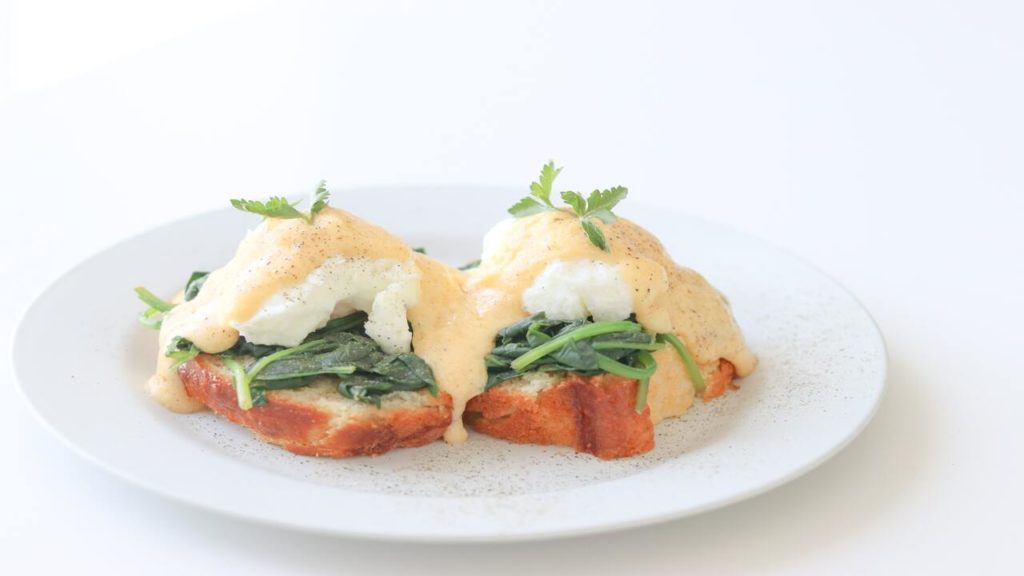Chemically, hollandaise sauce is an emulsion using clarified butter, acidic water (water and lemon juice), and egg yolks.
Because the butter’s fat and the water are immiscible, that is, don’t mix, the combination is only possible thanks to the egg yolks, which are soluble in both liquids acting through their emulsifying particles perfectly bonding the ingredients.
Gastronomically speaking, the success or failure of obtaining a shiny and homogeneous hollandaise sauce depends solely on the cook’s skills in combining all of these ingredients.
Hollandaise is one of the five mother sauces in French cuisine and is especially suitable for serving fish and vegetables. It is perhaps most famously used to top a brunch classic, the Eggs Benedict, or to coat steamed asparagus, besides being the main body for other derivative sauces.
Hollandaise sauce for me was… being able to do something that was so refined and had such history to it. I still find great joy in making hollandaise.
THOMAS KELLER – American chef, restaurateur and writer
Jump to Section
- Hollandaise Sauce: The Origin
- 5 Mistakes That Can Break Your Hollandaise Sauce
- 7 Essential Tips That Lead To A Perfect Hollandaise Sauce
- Classic Dishes With Hollandaise And Derivative Sauces
- Derivative Sauces
- Hollandaise Sauce: How To Prepare A Classic Recipe
The Origin

Sauce Hollandaise is French for ‘Dutch sauce.’ Although the name implies Dutch origins, the real connection is unclear. Instead, most historians agree that it was initially called Sauce d’Isigny. Isigny-Sur-Mer is a part of Normandy historically famous for its high-quality dairy products.
Although its exact birth date is unknown, the first documented recipe is from 1651 in François Pierre La Varenne’s book “Le Cuisinier François,” for ‘asparagus with fragrant sauce.
make a sauce with some good fresh butter, a little vinegar, salt, and nutmeg, and an egg yolk to bind the sauce; take care that it doesn’t curdle.
FRANÇOIS PIERRE LA VARENNE – french chef and writer
In the 19th century, sauces were classified into four categories by Marie-Antoine Carême. One of his categories was Allemande, a stock-based sauce with egg and lemon juice.
Later, in the 20th century, Georges Auguste Escoffier replaced Allemande with Hollandaise in the mother sauces category.
Since then, Hollandaise has been one of the most essential sauces in haute cuisine by mixing emulsified egg yolk with unsalted butter and fresh lemon juice.
5 Mistakes That Can Break Your Hollandaise Sauce

A broken Hollandaise sauce is grainy and very thin, which means the liquid and fat components have separated.
When making an emulsified sauce, avoid the following mistakes:
Overheating
Applying too much heat will scramble the yolks or separate the components while gently simmering the water is the perfect way to emulsify the eggs.
Overcooking
Egg yolks lose their ability to emulsify the sauce when cooking for a long time as they harden as they cook. When the emulsion reaches the ideal texture, almost like mayonnaise, smooth, shiny, and smooth.
Overloading on ingredients
If you over-season, the sauce will become unstable if you add too much butter or lemon juice and a pungent flavor. To prepare appropriately, each batch of sauce must strictly follow the amounts specified in the recipes.
Improper mixing
Each ingredient has its moment and speed to be added to the others. By adding elements quickly, the sauce will lose its ability to incorporate them properly. The general rule is that emulsified sauces, like hollandaise, must be done slowly by drizzling clarified butter into the egg yolks.
Ignore the recipe
Ignoring the recipe directions can ruin your entire hollandaise sauce. So don’t skip or switch steps. Understanding a recipe requires some reading and attention before starting cooking. Over time, we became familiar with the ingredients and the preparation method, but over time.
7 Essential Tips That Lead To A Perfect Hollandaise Sauce
Although it seems like an easy recipe, hollandaise sauce hides some tricks to make it. To master a perfect sauce, follow these essential tips.

Mise en Place
Mise en place is a French culinary term that means “to put everything in place.” In practice, it is an essential step before preparing any recipe; you will organize the kitchen utensils and portion the ingredients in advance, avoiding mess and mistakes at the time of preparation. Therefore, get everything organized and portioned before starting the preparation of the Hollandaise sauce; for example:
- Portion the ingredients according to the recipe.
- Clarify the butter.
- Prepare the water bath.
- Start the preparation.
Get rid of residues
Any presence of residues can reflect and ruin the flavor and appearance of the sauce. So keep pots and pans clean. Remember that Hollandaise is blond in color, revealing any dirty present in the sauce.
Mixing Yolks & Butter
clarified butter’s temperature has to be around 145ºF / 63ºC to be incorporated into the emulsified yolks. Generally, the egg-butter ratio is about one yolk for every 85g of clarified butter. Recipes that deviate significantly from this can ruin your sauce.
Double-boiler
When whisking yolks in a mixing bowl over a saucepot (double-boiler) with simmering water, it will take about 2 1/2 to 3 minutes until yolks thicken and have a fluffy consistency and pale yellow aspect. Most importantly, the yolks’ temperature doesn’t exceed 149ºF / 65ºC, or it will start curdling.
Avoiding curdling
If the yolks show signs of curdling on the sides and bottom of the mixing bowl, remove them from the heat and place them on a cold surface. Stir until cool, and return to the water bath again.
Fixing the consistency
Add a little hot water or lemon juice until you get the desired consistency when incorporating the butter and noticing that the sauce has become too thick.
Serve Immediately
Serve Hollandaise immediately for two reasons: First, its texture will change after a couple of minutes of preparation, becoming thicker. Second, it is an egg-based sauce, which requires temperature control to avoid entering the danger zone, as mentioned by the food safety regulation. However, if you serve it within 2 hours, keep the sauce in a water bath at temperatures between 145º – 149ºF / 63º – 65ºC. Never reheat the sauce.
Classic Dishes With Hollandaise And Derivative Sauces
There are incredible classic dishes and many ways you can use hollandaise sauce to take your cooking to the next level.
- Medium rare steaks with Bérnaise sauce
- Smoked Salmon On A French Baguette with Hollandaise Sauce
- Grilled Branzino with Hollandaise sauce
- Seared Salmon with Hollandaise sauce
- Lamb chops with Paloise sauce
- Scallops with Mousseline sauce
- Grilled Asparagus with Maltaise sauce
Hollandaise Derivatives Sauces
Derived sauces can be made by adding ingredients to the main sauce. As hollandaise sauce is versatile, there are 8 variations that can be made and served with eggs, vegetables, fish, seafood, poultry, pasta, meat, etc.
Hollandaise Sauce: How To Prepare A Classic Recipe
Although it has few ingredients and the method of preparation seems simple, hollandaise sauce requires attention and practice, especially when emulsifying the yolks with clarified butter.
Follow now on how to prepare the classic emulsion of French cuisine.
Now, get to work! 😋

Hollandaise Sauce
Equipment
- Whisk
- Mixing Bowls
- Small saucepan
- Medium pot
- Sieve
Ingredients
- 4 pcs Egg yolks
- 60 ml Water
- 250 g Clarified butter
- 1 pc Lemon Juice
- 10 pcs Black peppercorn
- Salt to taste
- Cayenne pepper to taste
Instructions
- In a small saucepan, bring the water and peppercorns to a boil and reduce by one-quarter.

- In the meantime, bring enough water to boil using the medium pot for water bath. Then reduce the heat to a simmer.
- Pass the water and peppercorns through a sieve in the mixing bowl and mix in the egg yolks using the whisk.
- Place the mixing bowl over the simmering water (water bath), combining the yolks and water in a figure-eight motion, rotating the bowl (about 2 to 3 min.),focusing for constant and gentle heat.
- Once the mixture reaches about 65ºC, it will thicken and will be fluffy consistency and a pale yellow appearance. Remove from heat and gradually whisk in the clarified butter in a steady stream until the texture looks like mayonnaise.
- Finish adding lemon juice, salt, and cayenne pepper to taste, while continuing to whisk.
- Serve immediately.
Notes
Did you make this recipe?
Please let me know how it turned out for you! Leave a comment below and share our content.
Please help our community grow by following our social media on Spotify, Instagram, Facebook, YouTube, and TikTok. And stay up to date with the news from the world of Gastronomy.
Don’t forget to tag @gastrovinoacademy on Instagram and hashtag it #gastrovinoacademy.
Cheers🍷


